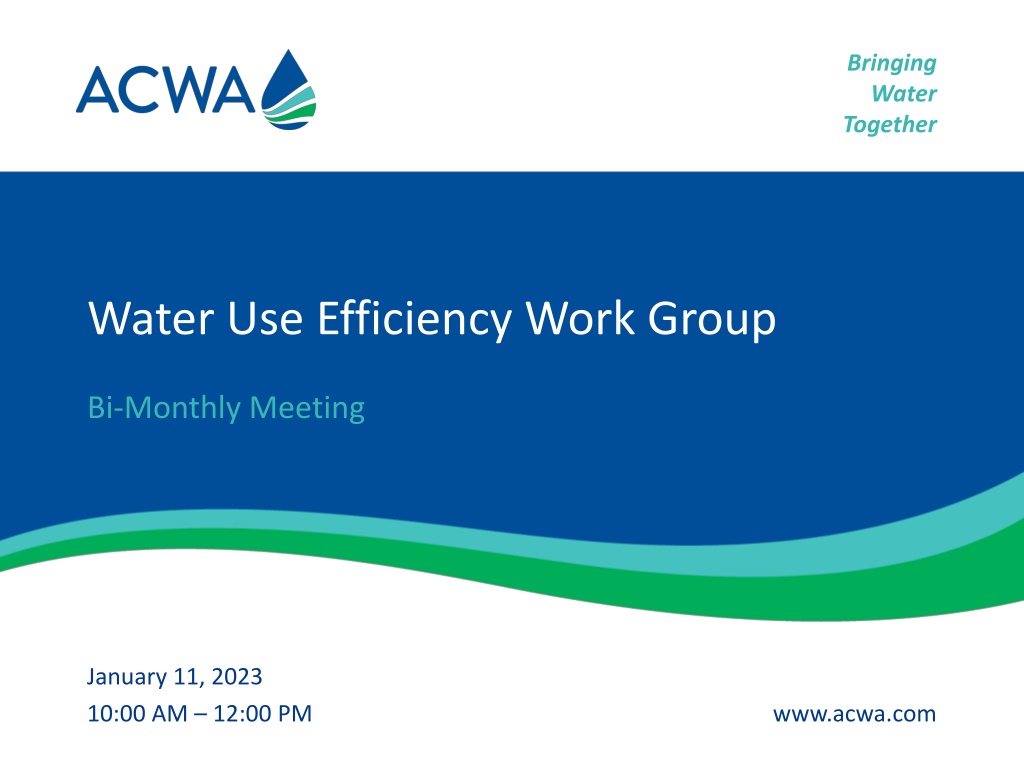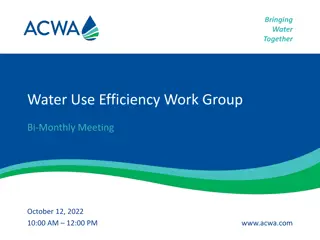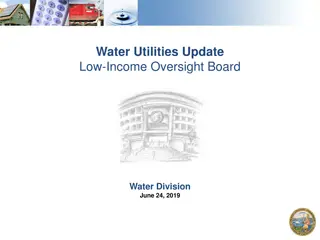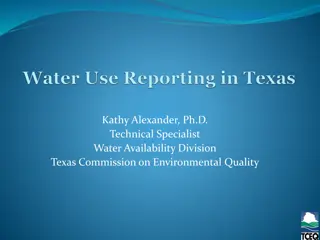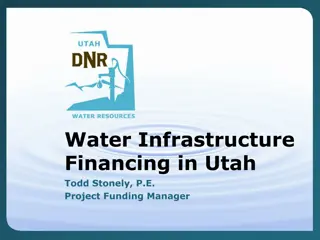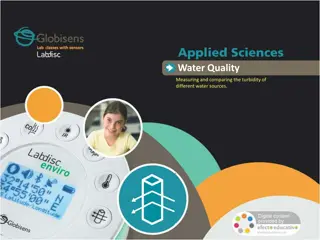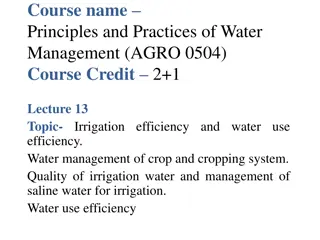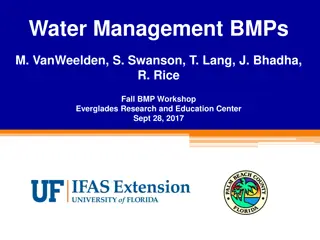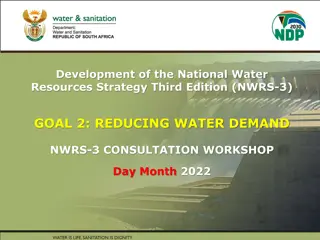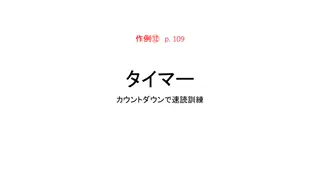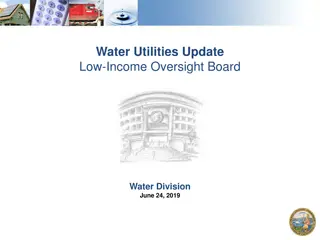ACWA Water Use Efficiency Work Group Meeting Summary
ACWA Water Use Efficiency Work Group held a bi-monthly meeting on January 10th, 2023, discussing key updates on drought, legislative matters, water use objectives, and next steps. The meeting covered topics such as drought updates, conservation reporting, legislative bills, water use standards, and performance measures. Discussions included concerns on regulations, compliance flexibility, and strategies for water use efficiency improvements in various sectors. Recommendations and timelines were set to address water management challenges effectively.
Download Presentation

Please find below an Image/Link to download the presentation.
The content on the website is provided AS IS for your information and personal use only. It may not be sold, licensed, or shared on other websites without obtaining consent from the author. Download presentation by click this link. If you encounter any issues during the download, it is possible that the publisher has removed the file from their server.
E N D
Presentation Transcript
Bringing Water Together Water Use Efficiency Work Group Bi-Monthly Meeting January 11, 2023 10:00 AM 12:00 PM www.acwa.com
Meeting Agenda January 10, 2023 10:00 AM 12:00 PM A. Chair Welcome Elizabeth Lovsted B. Drought Update Chelsea Haines C. Drought & Conservation Technical Reporting Order Chelsea Haines D. Legislative Update Julia Hall E. Water Use Objective Updates Elizabeth Lovsted i. CII Performance Measures Ariel Flores ii. Outdoor Residential Water Use Standard Fiona Sanchez iii. Variances Elizabeth Lovsted iv. Bonuses Fiona Sanchez F. Next Steps
Drought Update Chelsea Haines Executive Order - Feb. 1 2023 EOs remain in full effect Expedited permitting of GW recharge Modified reservoir operations State agencies to send recommendations by April 28 on necessary drought responses
Chelsea Haines Drought & Conservation Reporting Order ACWA Concerns o Public Process o Purpose/ Benefit o Duplicative Reporting o Burden on Water Suppliers Technical Concerns o Each Groundwater Well o Each Surface Water o Water loss
Legislative Update Julia Hall AB 1572 (Freidman) AB 1072 (Wicks)
Water Use Objective Update Elizabeth Lovsted Individual System Loss Standards or alternative compliance pathway 42 gpcd by 2030 Defined in legislation *Sufficient evidence supports the establishment of 8 variances identified in the legislation *0.63 ETF by 2030 * DWR recommendation; not final
Water Use Objective Update Elizabeth Lovsted Next Steps: o Standardized Regulatory Impact Assessment (SRIA) Any Day (visit link) o March 22 State Water Board Workshop ACWA has requested a water supplier panel Board may provide guidance to staff o Formal Rulemaking o End of the Year Adoption?
CII Performance Measures Ariel Flores ACWA Overarching Concerns 1. Implementation timelines and compliance should provide flexibility, rather than being prescriptive. PM should support suppliers efforts or strategies to advance WUE in the CII sector. URWS compliance should be determined by local and regional availability of PMs, rather than customer level adoption. Simplify reporting burdens on URWS. The State should provide technical assistance and data as soon as possible. Recognize CII LAM mapping will improve data for the CII DIM standard. 2. 3. 4. 5. 6.
CII Performance Measures Ariel Flores Summary of DWR Recommendations o Classification: URWS to map CII water use accounts into 19 classifications (by Year 5, with 20% mapping annually). o BMP: URWS to develop a CII Supplier BMP Implementation Program (by Year 3) that identifies one CII Water Supplier BMP for each of the 5 categories of actions. URWS to identify targeted CII water users and sectors that exceed a threshold of significance and associated BMPs. o MUM Conversion Threshold: For landscapes areas of 1 acre of greater on a per-parcel basis that are irrigated by a mixed-use meter, URWS must either (1) convert the MUM to a dedicated irrigation meter (DIM) (or equivalent technology) or (2) implement an In-Lieu Technology. o In-Lieu Technologies: By Year 1, URWS must prepare an In-Lieu technologies Implementation Plan. By Year 6, URWMS must implement in-lieu technologies for landscapes above the Conversion Threshold. In-Lieu technologies include water budget- based rate structures; hardware improvements with enhanced performance; remote sensing combined with other data and hardware improvements; landscape plant palette transformation programs, and others (as approved by the SWRCB).
Outdoor Recommendation Fiona Sanchez DWR Recommendation: o Existing Landscapes: 0.8 ET Factor (ETF) 2023 2030; 0.63 ETF 2030 and beyond o New Construction (Post Jan 1, 2020): Residential 0.55 ETF; 0.45 ETF Non- Residential o Special Landscape Areas: 1.0 ETF o 20% of Irrigable, Not Irrigated (INI) o Up to 25% of calculated Effective Precipitation Policy Considerations ORWUS Methodology ACWA Recommendation: o Adopt DWR s recommendation of 0.8 ETF through 2030. o By 2030, the State Water Board should evaluate URWS new LAM and provide a recommendation for a 2040 ORWUS that is based on a real world data, is based on a horticultural approach, is feasible and supports healthy, water efficient landscapes. o New Residential landscape should be 0.65 ETF o Remove effective precipitation
Outdoor Recommendation Fiona Sanchez ACWA Methodology Concerns: Policy Horticultural Approach: Assumed 0.8 Irrigation Efficiency (IE).ACWA Recommendation: A weighted IE between a range of 0.55 to 0.65 should be used. A Statewide ETF: Trimmed Data > 1.0. ACWA Recommendation: All landscape data should be included to provide a more accurate baseline. Theoretical Average: Assumes all homes are compliant with MWELO and applies corresponding ETAF. ACWA Recommendation: This methodology is fundamentally flawed with MWELO application and should be eliminated. Considerations o o ORWUS o Methodology ACWA Additional Policy Recommendations: o Timeline A minimum of 10 years from the time of State Water Board adoption is necessary for URWS to responsibly comply with an adopted standard that may be lower than 0.8 ETF (to secure the funding needed, educate customers, develop partnerships and technology advancements) . o Compliance If an URWS has robust outdoor water use efficiency programs and is not meeting the overall objective, the State Water Board should give deference to and partner with URWS to develop a reasonable standard prior to taking any enforcement.
Outdoor Recommendation Fiona Sanchez ACWA Additional Policy Recommendations: Policy o Alternative Landscape Data If a water supplier has more accurate landscape area data, subject to defined criteria and approved by the Department of Water Resources, the State Water Board should develop a revised, reasonable standard that maintains a commitment to ongoing water use efficiency. Considerations ORWUS o Funding and Technical Assistance Significant State funding and technical assistant will be necessary to support any ORWUS. Methodology o Special Landscape Areas in Residential Parcels ACWA supports the recommended 1.0 ORWUS for special landscapes areas. o 20% of INI ACWA supports the inclusion of 20% of INI landscape areas into the ORWUS We may want to make the point that, even as technology improves, times is needed to bring these new technologies to market and for them to become widely adopted by the industry Challenges: State and other Interested Parties Perspectives expressed o o o o Water Supply Strategy 500,000 AF by 2030 WUE is cheapest option, multi-benefits Water suppliers won t do this unless they are regulated to; backsliding Threat of Climate Change & been at this a long time, need to react now
Outdoor Recommendation Fiona Sanchez Policy Considerations Regardless of standard, what tools will be necessary for water suppliers to meet objective? ORWUS Methodology
Elizabeth Lovsted Methodology & Variances
WUE Objective Update: Bonus & Guidelines Fiona Sanchez
Chelsea Haines & Elizabeth Lovsted Next Steps
Questions and Comments? Chelsea Haines, Regulatory Relations Manager Chelseah@acwa.com
